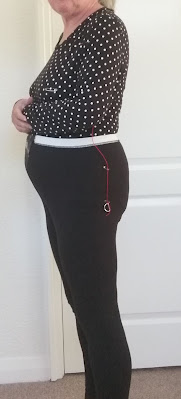Aesthetics warning: This is an everyday body, photos taken without filters, just using a phone clipped to the back of a dining chair. Apologies for the poor layout - as I've dragged the images around in blogger the formatting has all gone awry. I'd rather concentrate on content for the time being than fix it.
What am I trying to achieve: I'm following along with Mrs Mole's fitting tutorial at https://fitforaqueen.wordpress.com/2022/07/22/getting-started/ I've dropped into her blog now and then, both for her hilarious descriptions and for her deep expertise. No way am I anywhere near that standard, but I'm hoping to gain a bit more understanding. One of my retirement projects is to move up from practiced* beginner level to somewhat improved improver.
What am I trying to fit? From the front and back, you wouldn't look twice. Not unusual for my demographic. BTW - the safety pins are not a statement. They were to mark measuring points, and occasionally to hold the tape measure.

Where on earth is my waist? I've struggled even with the most basic. Yes, I know they say use the bend point, and I use the lower of the two I can feel, just above my hip bones.. I read that it isn't necessarily your smallest measurement. That's certainly true, my empire line is much smaller. One thing I learned in the last year was that your waist elastic can't be too thin - it'll walk- or too wide - if your curves are steep. I've known for a long while that it can't be stretched or it will try walk to a smaller part of the body (the unstable equilibrium dilemma). My workround is to use the elastic waist on some altered leggings (can't walk up), measure to the bottom of the elastic most of the way round, and to the top at centre front to compensate for the dip where the front goes over my belly.
And where are my hips? Well, the standard figure has a definite increase from high hip/abdomen to low hip, about 8" below the waist. But I have such a tilt on my pelvis, and my sway back pushes my tummy so much forward, that my bigger measurement is at high hip, 3.5" below the waist. For three quarters of that girth, the bone isn't far under the skin, though I admit to a little extra padding at the front. It means I have to increase abruptly just below the waist, and I haven't yet got wovens** to work without waist darts at the back as well as changing the slope at the side. I also compromise for tops and dresses by using at least the bigger measurement at low hip, because it has to cope with the empty space under my tum.
What is back and what is front? This has been the hardest part to work out. I've tried and failed yet again with 'pin a string with a weight to the centre of your armpit, and measure vertically down from there'. You will see a red thread and a d-ring in the ninja side photos, though I wish I'd used a slightly heavier weight. The snaps below show how unbalanced the top looks from the side. It's not just an appearance thing. With the side seams so far back, the bust dart would need to be shaped to fit flatly at the sides. Even worse results came from the sensory approach 'poke your side gently till you get the sensation of back or front. There's a weird sensation at the mid point, which will be the changeover' That gave me a low hip even further back, a waist further forward, and a bust further back. After attempting to smooth a little, my second try was even worse. What I settled on was to pin the string at a repeatable point, in my case where the band on a particular bra was vertically below the mid point of my armpit. Then add 1" to all the back measurements, and take it off all the front measurements. This worked for me, but as a retired software engineer I have learned to be wary of fudge factors. At least I know it's a fudge, which depends on the length and the angle of the spine, and can use it repeatably or adjust it as my shape evolves.






No comments:
Post a Comment